Aparajita (Clitoria ternatea): Key Differences From Shankhpushpi
What is Aparajita (Clitoria ternatea)?
Aparajita, scientifically known as Clitoria ternatea, is a captivating flowering plant that has captured the attention of botanists, herbalists, and nature enthusiasts alike. Native to Southeast Asia and commonly found in tropical regions, this perennial herbaceous plant belongs to the Fabaceae family, renowned for its unique and vibrant blue flowers.
Aparajita Flower and Family
The Aparajita plant stands out due to its striking indigo-blue flowers, which bear an uncanny resemblance to the female reproductive organ, lending to its scientific name “Clitoria.” The Fabaceae family, also known as the pea family, encompasses a diverse array of plants, including legumes like beans and lentils. Aparajita’s inclusion within this botanical lineage further highlights its significance and potential. 
Vernacular Names of Aparajita (Clitoria ternatea)
-
English Name: Butterfly Pea
-
Hindi: Koyala
-
Telugu: Dintena
Sanskrit Synonyms of Aparajita
-
Asphota – Named for its dehiscent (bursting) fruit.
-
Vishnukranta – Considered sacred and associated with Lord Vishnu.
-
Shveta / Mahashveta – Refers to white-flowered varieties.
-
Girikarni – Leaves resemble the ear of a rat.
Classical Categorization
-
Charaka Samhita: Included under Shiro Virechanopaga – a group of herbs useful for Nasya (nasal therapy) in Panchakarma.
-
Bhavaprakasha Nighantu: Classified under Guduchyadi Varga – a group of herbs known for rejuvenative and medicinal properties.
Medicinal Properties (Pharmacological Attributes)
-
Rasa (Taste):
-
Katu – Pungent
-
Tikta – Bitter
-
Kashaya – Astringent
-
-
Guna (Qualities):
-
Laghu – Light in digestion
-
Rooksha – Dry in nature
-
-
Vipaka (Post-digestive taste):
-
Katu – Undergoes pungent transformation after digestion
-
-
Veerya (Potency):
-
Sheeta – Cooling in nature
-
-
Effect on Tridosha:
-
Tridoshahara – Balances all three doshas (Vata, Pitta, Kapha)
-
Special Effects and Actions
-
Medhya – Enhances intellect and memory
-
Pharmacological Actions:
-
Intellect promoter
-
Laxative
-
Diuretic
-
Anthelmintic
-
Aphrodisiac
-
Benefits of Aparajita (Clitoria ternatea)
The Aparajita plant boasts a plethora of potential benefits, both traditional and modern. Its historical use in Ayurvedic and traditional medicine systems underscores its importance as a natural remedy. Some potential benefits of Aparajita include:
1. Cognitive Enhancement and Stress Relief
People have revered Aparajita for its potential to enhance cognition, with beliefs that it supports memory, focus, and overall brain health. Furthermore, it is thought to possess adaptogenic qualities that help reduce stress, promoting a sense of calmness and mental clarity.
2. Antioxidant Richness
Rich in antioxidants, Aparajita flowers contain compounds that combat oxidative stress and may contribute to cellular well-being. Antioxidants play a crucial role in neutralizing free radicals and supporting the body’s defense against various ailments.
3. Skin and Hair Care
The plant’s bioactive compounds have led to its incorporation in cosmetic products aimed at promoting healthy skin and hair. Its potential to rejuvenate and nourish the skin and hair has garnered attention from beauty and wellness enthusiasts.
4. Respiratory Support
In traditional practices, Aparajita has been used to address respiratory concerns. Its potential to provide relief from common respiratory discomforts has spurred interest in exploring its applications in this realm.
Ayurvedic Formulations of Aparajita (Clitoria ternatea)
These Ayurvedic preparations offer a natural approach to addressing a range of health concerns. Let’s delve into some notable Ayurvedic formulations that incorporate the essence of Aparajita:
1. Aparajita Herbal Tea Blend
Crafted by blending dried Aparajita flowers with other complementary herbs, this soothing herbal tea aims to provide a harmonious synergy of wellness benefits. Infusing Aparajita’s vibrant blue petals with herbs such as holy basil (Tulsi) and Brahmi results in the creation of a nourishing beverage. This concoction is believed to enhance cognitive function, alleviate stress, and promote overall vitality.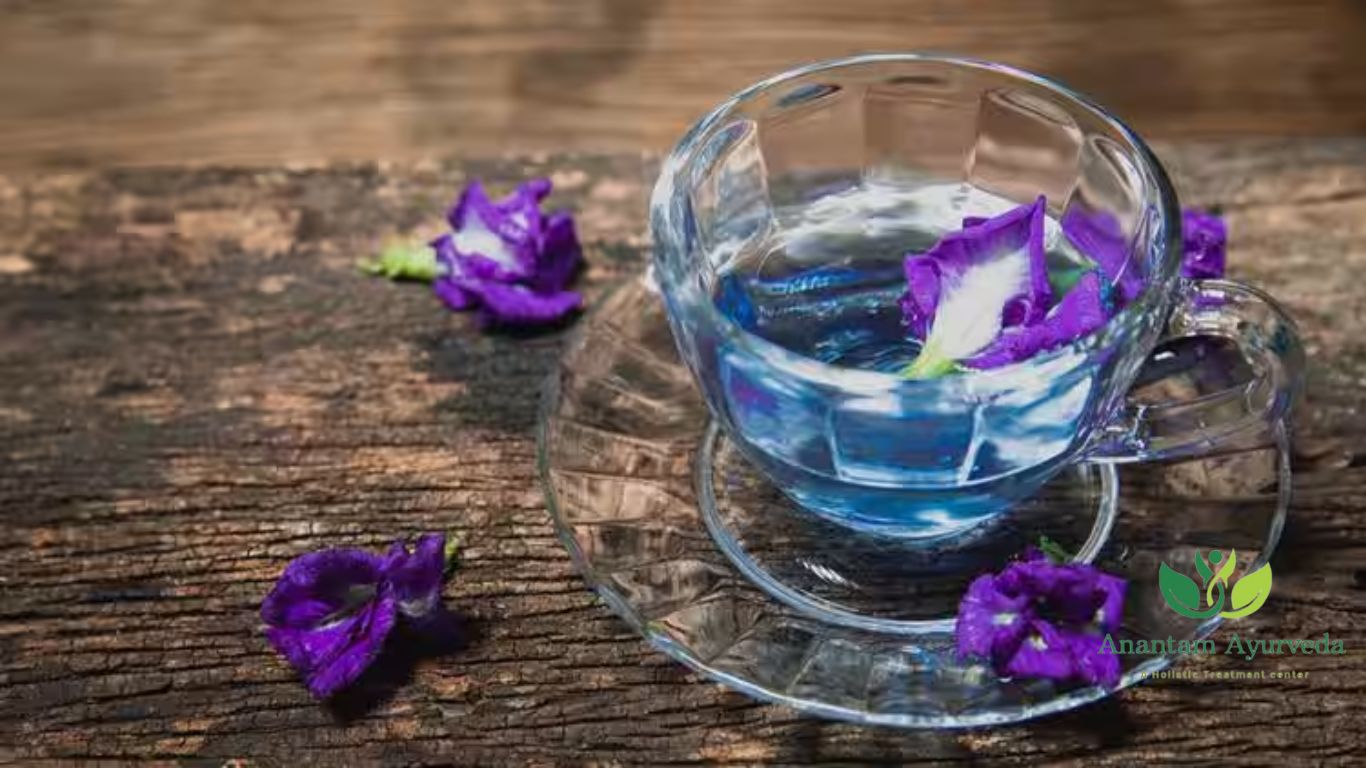
2. Aparajita Rasayana
Rasayana, a term in Ayurveda, refers to formulations that support rejuvenation and longevity. Aparajita Rasayana combines the potency of Aparajita with select herbs, spices, and natural ingredients to create a tonic that may contribute to enhanced vitality, improved immunity, and balanced well-being. This preparation is often revered for its adaptogenic properties, helping the body adapt to stressors and maintain equilibrium.
3. Aparajita Oil Infusion
Infusers can infuse Aparajita flowers into carrier oils, resulting in the creation of a versatile Ayurvedic oil suitable for massage and topical application. This oil is believed to provide nourishment to the skin, offer a soothing effect on the senses, and promote relaxation. Regular use of Aparajita-infused oil may contribute to a sense of tranquility and overall sensory wellness.
4. Aparajita Churna (Powder)
Carefully grinding dried Aparajita flowers results in the creation of Aparajita Churna, a fine powder. This powdered formulation offers convenience as it can be easily added to foods, beverages, or mixed with warm water. Aparajita Churna finds common usage in supporting mental clarity, enhancing cognitive health, and contributing to a gentle detoxification effect on the body.
5. Beauty Elixir
Recognizing Aparajita’s potential benefits for skin and hair, this Ayurvedic elixir blends Aparajita extracts with rejuvenating herbs like Neem, Manjistha, and Aloe Vera. The elixir is thought to nourish the skin, promote a healthy complexion, and strengthen hair. Regular use may contribute to a natural radiance and inner vitality.
6. Ghrita (Ghee Formulation)
Infusers occasionally infuse Aparajita into clarified butter (ghee), resulting in the creation of Aparajita Ghrita. This formulation garners high regard for its potential in supporting brain health, memory, and cognitive function. Believers hold that Aparajita Ghrita heightens the absorption of the plant’s beneficial compounds, and practitioners frequently utilize it as a traditional tonic.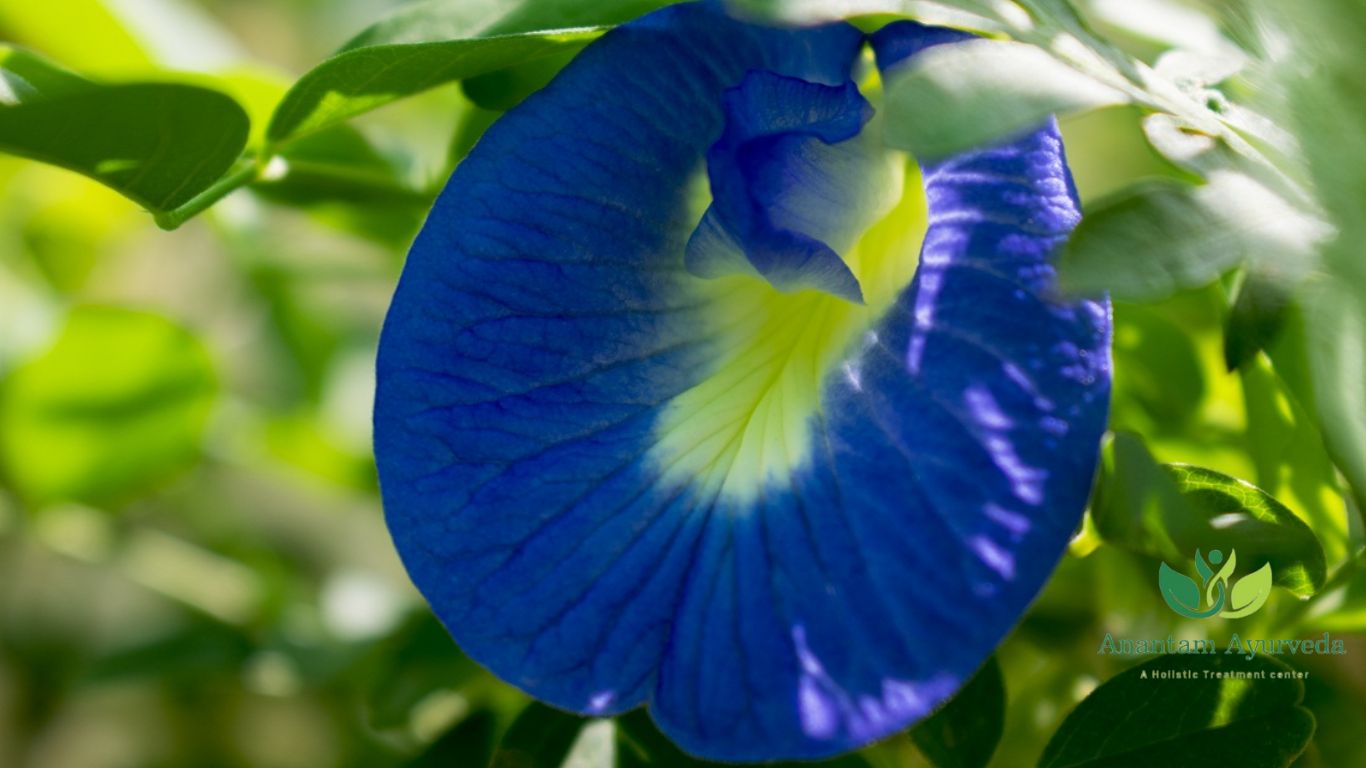
Parts Used
-
Root bark
-
Root
-
Seeds
Dosage
-
Churna (Powder): 1–3 grams
Dietary Recommendations
Recommended Foods:
-
Healthy fats: Ghee, coconut oil, flaxseed oil, fish oil, egg oil, krill oil
-
Seeds & nuts: Sunflower seed, almond, pistachio, flax seeds, walnut, chia seeds
-
Vegetables: Broccoli, carrots, chard, red peppers, pumpkin, cauliflower, brussels sprouts, winter squash
-
Fruits: Papaya
-
Protein sources: Soybean, tofu
-
Other: Camellia (likely Camellia sinensis – tea), taro root
Important Notes:
-
Prefer homemade food.
-
Avoid all types of junk foods and sodas.
-
No specific restrictions, but healthy eating is encouraged.
Controversies & Clarifications
-
The term Aparajita is not explicitly mentioned in the Brihatrayi texts.
-
Shveta and Mahashveta are listed under Shiro Virechanopaga varga.
-
According to Acharya Chakrapani, Shveta refers to Aparajita and Mahashveta to Katabhi.
-
Under Vayasthapana, Shveta may refer to a variety of Rasna, per Chakrapani.
-
-
In Southern India, Aparajita (Clitoria ternatea) is often considered the plant source of Shankhapushpi.
Varieties
-
Bhavaprakasha Nighantu:
-
Shvetapushpa Aparajita (White-flowered)
-
Nila Pushpa Aparajita (Blue-flowered)
-
-
Raj Nighantu:
-
Ashvaksura
-
Nila Aparajita
-
Morphological Description
-
Habit: Slender vine or climber
-
Root: Taproot system, branched, nodulated
-
Stem: Slender and green
-
Leaf: Compound, imparipinnate, leaflets ovate/oblong with reticulate venation
-
Inflorescence: Axillary, cymose, solitary flowers
-
Flowers: Blue or white in color
-
Fruit: Pod; seeds are non-endospermic
Uses of Flower – Butterfly Pea Flower Tea
-
Prepared as an herbal tea
-
Benefits:
-
Boosts immunity
-
Reduces inflammation
-
Relieves headache
-
Helpful in joint disorders
-
How to Use Clitoria ternatea?
Incorporating Aparajita into your wellness routine can be achieved through different means:
1. Herbal Teas and Infusions
Aparajita flowers can be brewed into a delightful and visually captivating herbal tea. The infusion process allows the extraction of the plant’s beneficial compounds, offering a soothing and aromatic beverage.
2. Powdered Supplements
People frequently grind dried Aparajita flowers into a fine powder, which they can then encapsulate or mix into smoothies and other beverages. This provides a convenient way to incorporate the plant’s potential benefits into your daily regimen.
3. Topical Applications
Aparajita extracts or oils are sometimes utilized topically, offering a means to nourish the skin and hair directly. These applications tap into the plant’s beauty-enhancing properties.
Best Time to Take Aparajita
The timing of consumption can influence its potential effects. Incorporating it into your routine during specific periods may optimize its benefits:
1. Mornings
Starting your day with Aparajita-infused tea may help set a positive tone, providing a sense of mental clarity and focus to kickstart your activities.
2. Evening Relaxation
Consuming Aparajita-infused products in the evening can contribute to relaxation and stress relief, aiding in winding down after a long day.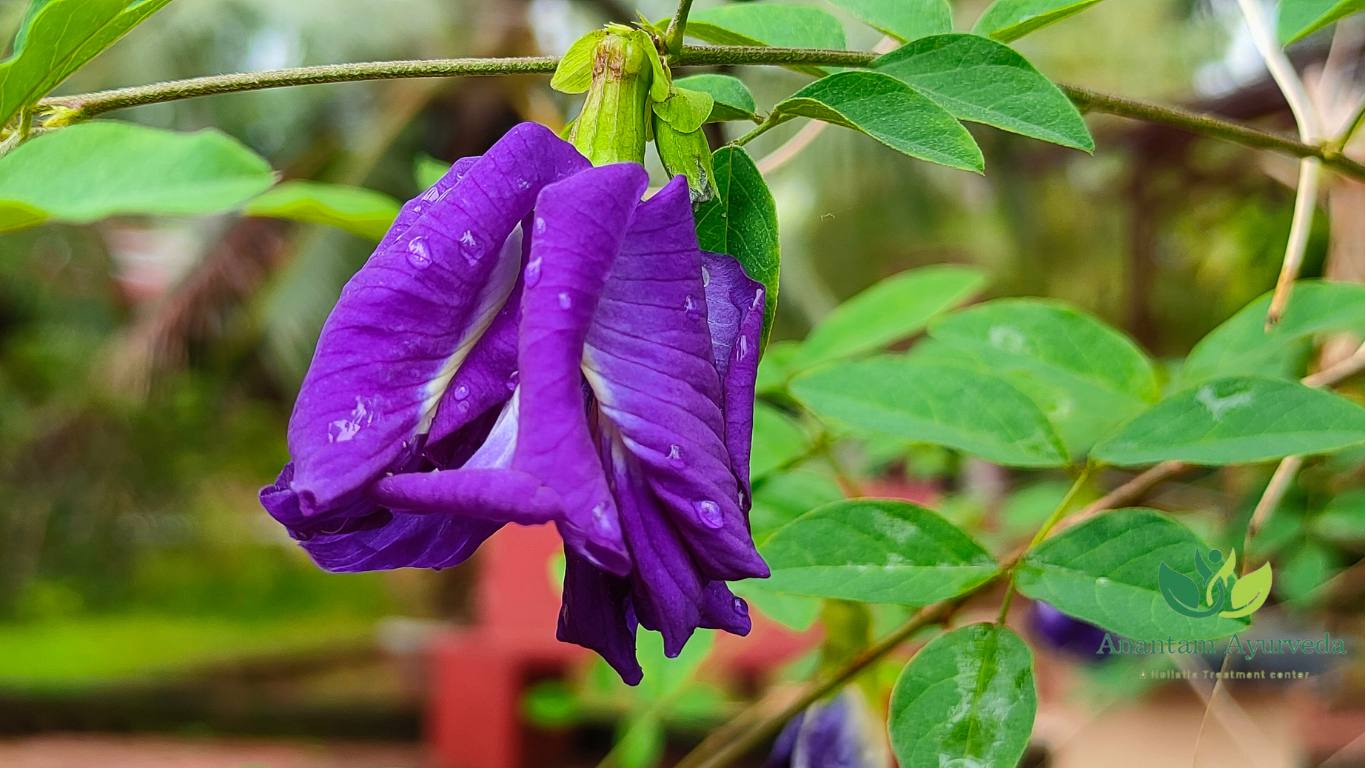
Classical Ayurvedic Formulations Containing Aparajita
-
Aparajita Ghrita
-
Text Reference: Ayurvedic Formulary of India (AFI)
-
Type: Medicated Ghee
-
Indications: Epilepsy (Apasmara), memory loss, and neurological conditions.
-
Properties: Acts as a Medhya Rasayana (brain tonic) and Shirovirechana (nasal detoxifier).
-
-
Aparajitadi Churna
-
Text Reference: Bhaishajya Ratnavali (Krimiroga Chikitsa)
-
Type: Herbal powder
-
Indications: Intestinal worm infestation (Krimi), indigestion.
-
Key Herbs: Aparajita, Vidanga, Haritaki, etc.
-
-
Aparajitakadi Taila
-
Text Reference: Regional and traditional usage; found in some South Indian practices.
-
Type: Medicated oil
-
Indications: External use in skin diseases and wound healing.
-
-
Krimighna Vati
-
Text Reference: Ayurvedic Formulary of India (AFI)
-
Type: Tablet
-
Indications: Anthelmintic (worm infestations)
-
Contains: Aparajita among other Krimighna (anti-parasitic) herbs.
-
-
Aparajitadi Kashaya
-
Text Reference: Traditional Kashaya preparations (mentioned in Kerala and Karnataka practices)
-
Type: Decoction
-
Indications: Skin diseases, fever, inflammation.
-
Note:
While Aparajita is not extremely common in many of the Brihatrayi (major three texts – Charaka, Sushruta, Ashtanga Hridaya) formulations under this exact name, it is referenced and used widely in Nighantu texts, regional classical practices, and AFI–listed formulations.
Side Effects of Clitoria ternatea
1. Allergic Reactions
Individuals with known allergies to plants in the Fabaceae family should exercise caution when using it, as allergic reactions may occur.
2. Gastrointestinal Distress
In some cases, excessive consumption may lead to mild gastrointestinal discomfort.
Modern Scientific Research Studies on Aparajita
1. Anti-Inflammatory Activity of Aparajita Root Decoction
-
Authors: Gangil Darpan, Patil Sumitra K, Chougala S B
-
Published in: International Journal of Ayurveda and Pharma Research, April 2016
-
Key Findings: The study evaluated the anti-inflammatory effects of Aparajita root decoction in albino rats. Results indicated significant anti-inflammatory action, comparable to diclofenac sodium, suggesting its potential as a natural anti-inflammatory agent. ijapr.ijraps.in+1Ijam+1
2. Therapeutic Potential of Aparajita: A Systematic Review
-
Authors: Laxmikant Paymalle, Nilima Wadnerwar
-
Published in: International Journal of Ayurvedic Medicine, January–March 2024
-
Key Findings: This review compiled preclinical studies highlighting Aparajita’s pharmacological activities, including diuretic, nootropic, anti-asthmatic, anti-inflammatory, analgesic, antipyretic, antidiabetic, antilipidemic, antioxidant, and wound healing properties. The authors emphasized the need for further clinical research to establish its therapeutic potential. Ijam
3. Phytochemistry and Medicinal Uses of Clitoria ternatea
-
Authors: Tamanna, Amanpreet Kaur, Navdeep Singh, Richa Shri
-
Published in: European Journal of Medicinal Plants, November 2024
-
Key Findings: The review detailed the phytochemical constituents of Clitoria ternatea, such as acylated anthocyanins (ternatins), cyclotides, and phenolic compounds. It highlighted the plant’s traditional uses as an antidote for snake and scorpion bites, memory enhancement, and its commercial applications as a natural dye and in cosmetics. Journal E JMP
4. Anti-Poisonous Properties of Shweta Aparajita
-
Authors: Baghel Sachinkumar, Shambharkar Nitesh Laxman, Agrawal Neeraj
-
Published in: International Journal of Applied Ayurved Research, January–February 2022
-
Key Findings: The study reviewed the traditional use of Shweta Aparajita in Ayurvedic formulations for treating various poisons, especially from animal bites. It noted the plant’s inclusion in several Agada (anti-poison) formulations and its pharmacological activities, including anxiolytic, anti-inflammatory, analgesic, and antimicrobial effects. ijaar.in
5. Phytochemical Analysis and Antimicrobial Activity Against Rice Pathogens
-
Author: Abhijit Debnath
-
Published by: Assam Agricultural University, July 2018
-
Key Findings: This research focused on the phytochemical composition of Aparajita and its antimicrobial activity against rice pathogens. The study confirmed the presence of bioactive compounds and demonstrated significant antimicrobial properties, suggesting its potential in agricultural applications. Krishikosh
6. Comparative Analysis of Blue and White Flower Varieties
-
Authors: G. Sankar, M. Madhavan, B. S. Kumar, A. Ajith
-
Published in: Journal of Scientific Research, 2024
-
Key Findings: The study compared the elemental composition and pharmacological activities of blue and white flower varieties of Clitoria ternatea from Kerala. Findings indicated that the white variety is beneficial for bone health, while the blue variety exhibits antioxidant, antidiabetic, and antifungal properties. Bangladesh Journals Online
7. Pharmacological Relevance of Clitoria ternatea
-
Authors: Adnan Raza, Swati, Mohd. Adil Tahseen
-
Published in: Journal of Pharmacognosy and Phytochemistry, 2024
-
Key Findings: The review highlighted the presence of various phytochemicals in Clitoria ternatea, including saponins, flavonoids, and anthocyanins. It discussed the plant’s pharmacological effects, such as antioxidant, hypolipidemic, anticancer, anti-inflammatory, analgesic, antipyretic, antidiabetic, and antibacterial activities. phytojournal.com
8. Phytochemicals and Medicinal Uses of Clitoria ternatea
-
Authors: Deepika Sahu, Jitendra Kumar Sahu, Vijay Kumar, Samir Kumar Tamrakar
-
Published in: International Journal of Plant & Soil Science, July 2023
-
Key Findings: The article discussed the traditional uses of Clitoria ternatea in Ayurvedic medicine for treating indigestion, constipation, arthritis, skin diseases, liver, and intestinal problems. It also emphasized the plant’s phytochemical constituents contributing to its medicinal properties. Int’l J Psychol Studies
9. Pharmacognostical Investigation of Clitoria ternatea Leaves
-
Authors: Shivnetra Rampalli, Bindu Gopalkrishnan
-
Published in: Plant Science Today, 2024
-
Key Findings: The study conducted a pharmacognostical investigation of Clitoria ternatea leaves, identifying their use in treating hepatic problems, earaches, and skin eruptions. The research provided insights into the microscopic and macroscopic characteristics of the leaves. Horizon e-Publishing Group
10. Protective Effects Against Obesity and Inflammation
-
Authors: Chayaratanasin et al.
-
Published in: Food Research International, 2022
-
Key Findings: The study demonstrated that blue petal extract of Clitoria ternatea protects against obesity, oxidative stress, and inflammation induced by a high-fat, high-fructose diet in mice. The extract showed potential in mitigating metabolic disorders. ScienceDirect
Difference between Aparajita and Shankhpushpi
Aparajita and Shankhpushpi often share mentions due to their roles in traditional medicine systems. While both hold revered positions for their potential cognitive benefits, they possess distinct characteristics: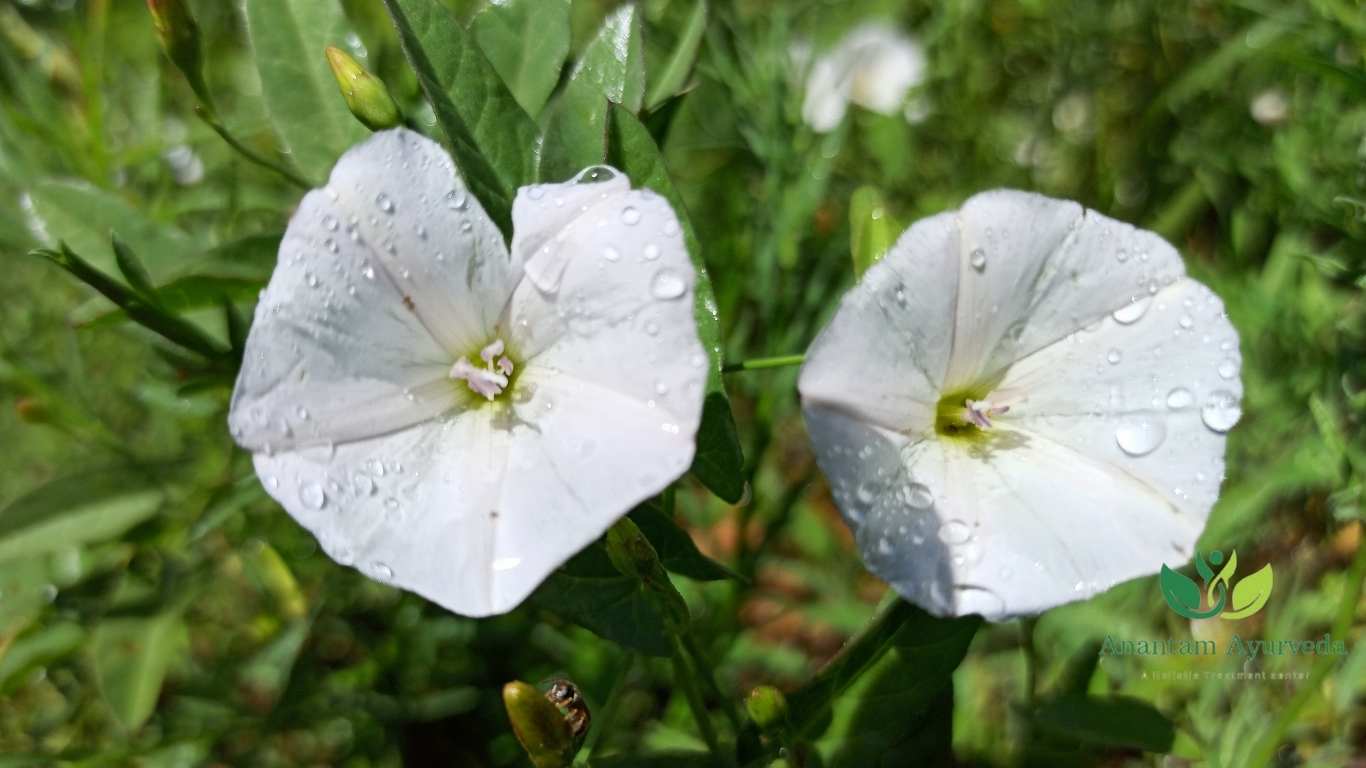
- Botanical Origin: Aparajita belongs to the Fabaceae family. In contrast, Shankhpushpi originates from different plant species, such as Convolvulus pluricaulis or Evolvulus alsinoides.
- Appearance: Aparajita flowers exhibit a striking vivid blue hue, while Shankhpushpi flowers typically manifest in shades of white or light blue.
- Traditional Uses: Ayurveda holds both plants in high regard for their cognitive-enhancing properties. However, Aparajita stands out for not only its cognitive benefits but also its potential for antioxidants and beauty-related advantages, an emphasis that Shankhpushpi may not share to the same degree.
Here you can watch our Youtube video about Key differences between these two plants
Key Differences: Aparajita vs. Shankhpushpi
| Feature | Aparajita (Clitoria ternatea) | Shankhpushpi (Convolvulus pluricaulis) |
|---|---|---|
| Family | Belongs to the Fabaceae family, which includes legumes and nitrogen-fixing plants. | Part of the Convolvulaceae family, commonly known as the morning glory family. |
| Common Name | Commonly known as Butterfly Pea due to its bright blue flowers. | Called Aloe Weed or Morning Glory because of its creeping growth and small flowers. |
| Appearance | A climbing vine with vibrant blue or white flowers, often used as an ornamental plant. | A low-growing, creeping herb with white or light purple flowers found in grasslands. |
| Primary Compounds | Rich in flavonoids, anthocyanins, and triterpenoids, which contribute to its antioxidant and anti-inflammatory effects. | Contains alkaloids, glycosides, and flavonoids, known for their neuroprotective and stress-reducing properties. |
| Brain Health Benefits | Enhances memory, learning ability, and focus, making it beneficial for students and professionals. | Boosts memory, cognition, and concentration, making it a powerful brain tonic. |
| Stress & Anxiety Relief | Helps the body cope with stress by reducing cortisol levels and promoting relaxation. | Acts as a natural adaptogen, calming the nervous system and reducing anxiety and stress. |
Neuroprotection |
Protects against Alzheimer’s disease and cognitive decline by preventing brain cell damage. | Supports brain cell regeneration, helps in managing epilepsy, and reduces the risk of neurodegenerative disorders. |
| Anti-Inflammatory Properties | Contains antioxidants that fight free radicals, reducing oxidative stress in the body. | Supports nerve function, reduces inflammation, and helps in the management of neural disorders. |
| Skin & Hair Benefits | Promotes healthy skin and hair growth by improving collagen production and scalp circulation. | Enhances skin tone, reduces wrinkles, and slows aging signs due to its rejuvenating properties. |
| Diabetes & Blood Sugar Control | Regulates blood glucose levels and enhances insulin sensitivity, making it useful for diabetes management. | Supports blood sugar regulation by improving metabolism and reducing oxidative stress in diabetic patients. |
| Cardiovascular Health | Strengthens heart function, improves blood circulation, and reduces the risk of heart diseases. | Helps lower blood pressure, regulate cholesterol levels, and promote overall heart health. |
| Primary Uses | Commonly used in herbal teas, skincare, and cognitive health supplements. | Found in brain tonics, stress-relief medicines, and sleep aids. |
| Common Ayurvedic Formulations | Often used in teas, powders, and extracts for enhancing mental clarity. | Found in Brahmi Ghrita, Medhya Rasayana, and other Ayurvedic brain-boosting formulations. |
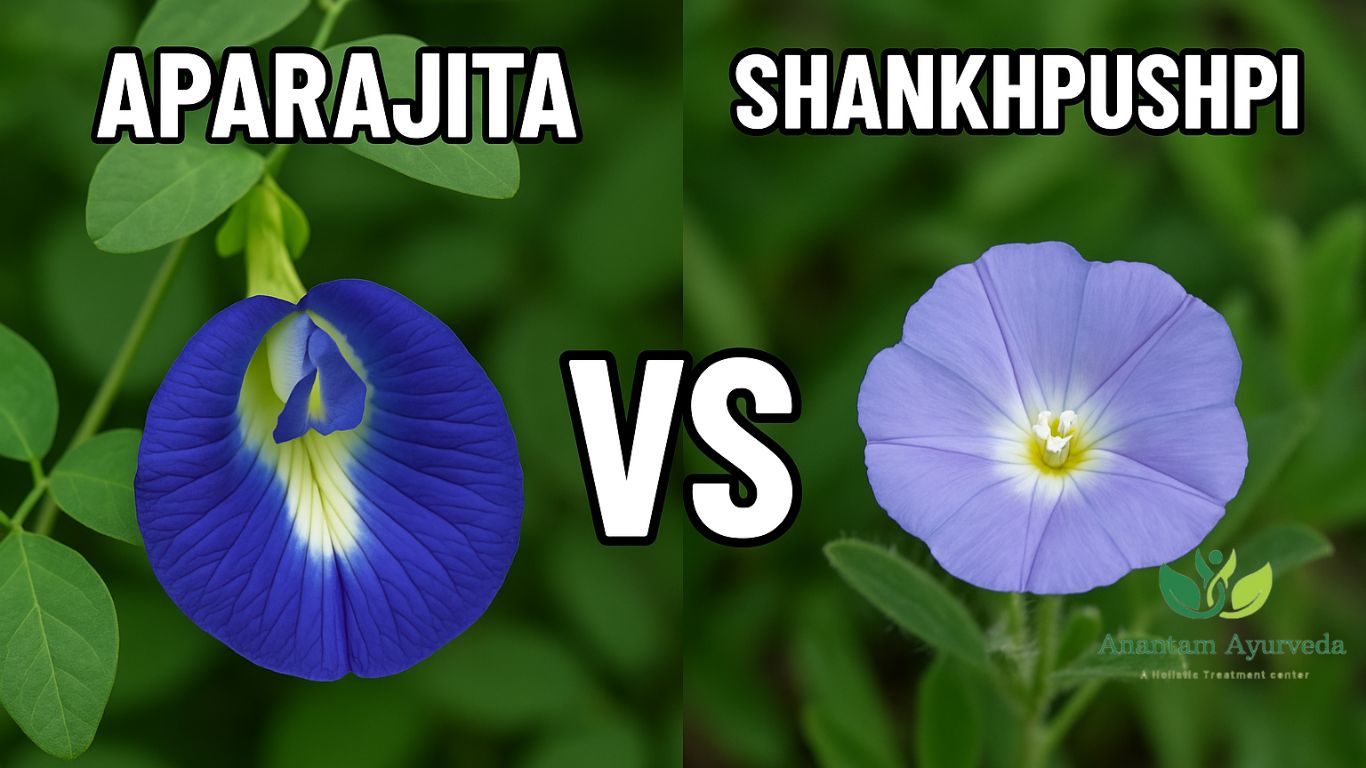 Which One Should You Choose?
Which One Should You Choose?
Choosing between Aparajita and Shankhpushpi depends on your health needs:
Choose Aparajita if you want to:
-
Improve brain function by boosting memory, focus, and learning ability.
-
Enhance skin and hair health with its rich antioxidants and collagen-boosting properties.
-
Manage blood sugar levels naturally and improve metabolism.
Choose Shankhpushpi if you need:
-
A natural brain tonic for cognitive enhancement and stress relief.
-
Support for anxiety, depression, and neuroprotection.
-
Heart health benefits, such as blood pressure regulation and cholesterol control.
Aparajita and Shankhpushpi play essential roles in Ayurveda, supporting brain health, emotional balance, and overall vitality. Their distinct properties make them valuable in herbal medicine and daily wellness routines.

In conclusion, Clitoria ternatea stands as a remarkable botanical treasure, celebrated for its potential cognitive, antioxidant, and wellness-enhancing qualities. As you embark on your journey to explore the wonders of this plant, remember to consult experts, consider Ayurvedic formulations, and embrace its holistic benefits. Unlock the potential of it, and let nature’s marvel contribute to your well-being.
Frequently Asked Questions (FAQs) about Aparajita
Is Shankhpushpi and Aparajita the same?
No, Shankhpushpi and Aparajita are not the same, although they are often confused due to their similar traditional uses.
-
Shankhpushpi (Convolvulus pluricaulis) is a renowned Medhya Rasayana (brain tonic) in Ayurveda. It is primarily used to enhance memory, concentration, and mental clarity. It typically has small blue or purple flowers and is known for its calming and nootropic effects.
-
Aparajita (Clitoria ternatea), commonly known as Butterfly Pea, is another blue-flowered plant used in Ayurveda and spiritual practices. It also possesses Medhya (brain-enhancing) qualities and is valued for its detoxifying properties, use as a diuretic, and various other health benefits.
While both support cognitive health, they are botanically different plants with distinct characteristics and applications.
What is Aparajita?
Aparajita, also known as Clitoria ternatea or Butterfly Pea, is a beautiful perennial vine with vibrant blue or white flowers. Ayurvedic practitioners value this plant for its therapeutic benefits.
What are the common names of Aparajita?
People call Aparajita by various names—Butterfly Pea, Asian Pigeonwings, Bluebellvine. In Hindi, it’s known as Koyala.
What are the different varieties of Aparajita?
Aparajita grows in two main flower types: blue and white. The blue variety is popular in teas and natural food dyes.
How to grow Aparajita at home?
Grow Aparajita in a warm, tropical climate with well-draining soil and plenty of sunlight. Water it regularly and prune occasionally to keep it healthy.
When does Aparajita bloom?
Aparajita blooms throughout the year in tropical climates. In temperate regions, it flourishes from spring to early autumn.
Can I grow Aparajita in pots?
Yes, you can grow Aparajita in pots. Use containers with good drainage and provide a trellis or support for the vine to climb.
What are the health benefits of Aparajita?
Aparajita offers antioxidant, anti-inflammatory, and brain-boosting benefits. Ayurveda uses it to improve memory, reduce stress, and support mental clarity.
How do Ayurvedic traditions use Aparajita?
Ayurvedic texts describe Aparajita as a Medhya herb that enhances cognitive function. It also helps treat respiratory problems, skin disorders, and acts as a natural detoxifier.
Does Aparajita have side effects?
Aparajita is generally safe in moderate amounts. Overconsumption may cause mild stomach discomfort. It’s wise to consult a healthcare expert before starting any herbal supplement.
Can I use Aparajita flowers in cooking?
Yes, Aparajita flowers are edible and make a stunning natural food dye. Use them in teas, rice dishes, smoothies, and desserts.
How to make Butterfly Pea Flower Tea?
Steep dried Aparajita flowers in hot water for 5–10 minutes until it turns deep blue. Add lemon juice to transform the color to purple and sweeten as desired.
What is the cultural importance of Aparajita?
Indian traditions consider Aparajita sacred. It’s often used in rituals and religious offerings to bring purity and positive energy into homes.
Does Aparajita hold spiritual significance?
Yes, Aparajita supports spiritual practices like meditation. Its calming nature helps reduce mental clutter and enhances spiritual awareness.
You can also read about Sarpagandha (Rauvolfia serpentina): Is It Good for Hypertension?
